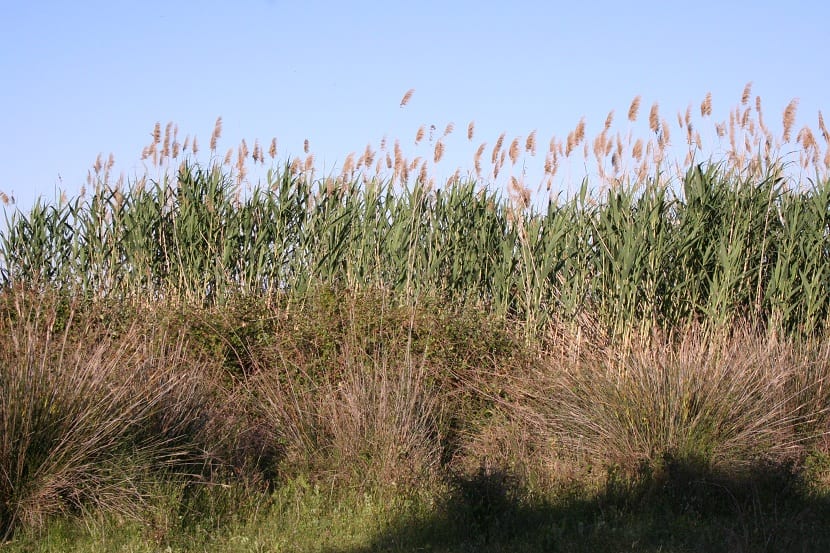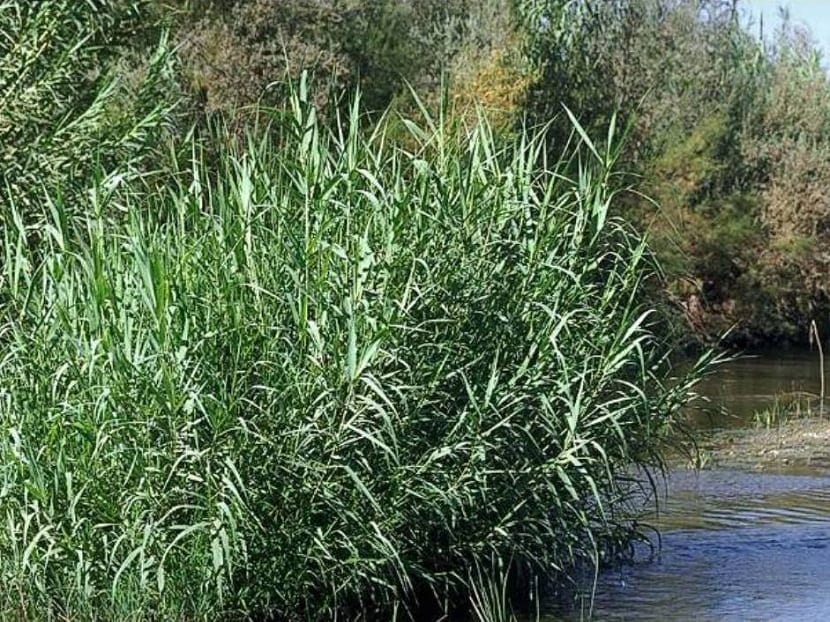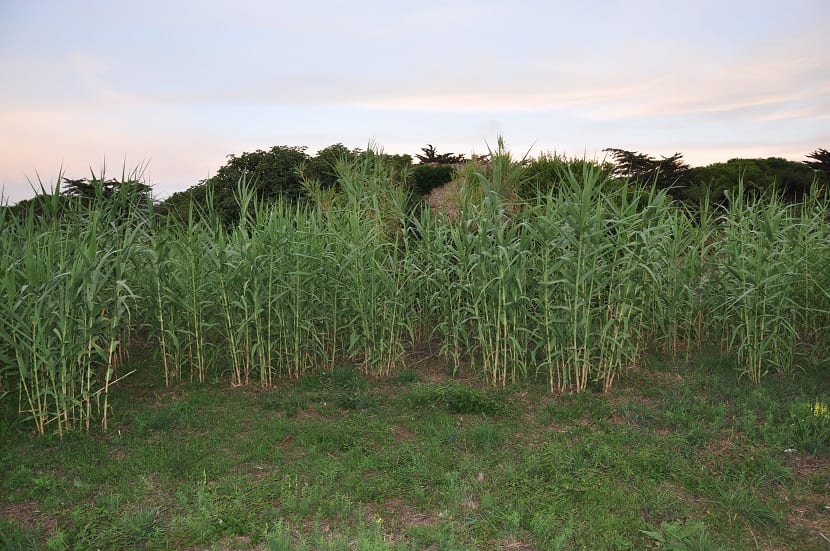
One of the most common plants that have ever existed is currently considered an invasive plant. It is the common reed. Its scientific name is arundo donax. As you surely know, it is a plant that has been widely used to make baskets, musical instruments, support for fruit trees, as tutors for some plants such as climbing plants, etc. It has been cultivated not for ornamental purposes but for some purpose. It is linked to the environment since there are many species of birds that nest or sleep in the reed beds.
In this article we are going to tell you everything you need to know about arundo donax and why it is considered an invasive plant.
Key features

The common reed also has an interesting use for energy purposes. It is used to be burned as fuel in biomass boilers. At present, the arundo donax It has been cultivated in our region and is now naturalized. We can find it in many temperate and not very cold zones, also in the subtropics and the tropics of both hemispheres. Its most abundant area is in the entire arc of the Mediterranean and California.
It is known by a multitude of common names such as cañavera, bardiza, carda, giant cane, large garden cane, wild cane, canaveira, canabela, canaberra, garritza, caña vera, cañavana, etc. It is native to East and South Asia. It belongs to the Gramineae family. It has a powerful, thick and long woody rhizome. Hence, it serves as good fuel in the use of biomass boilers.
It has a great vigor that, depending on the growing conditions, can grow from 2 to 6 meters in height. They usually persist for more than a year and the next they branch out laterally. The stems are called canes and are completely hollow and formed by knots every 10 to 30 cm long. It is the knots that give it the stability it needs. Otherwise, they could not grow in altitude.
The rhizome has a fleshy appearance and serves to reserve carbohydrates. It normally develops at a depth of between 5 and 15 cm. They are capable of penetrating the ground more than one meter. The rhizomes expand horizontally and branch out in order to colonize parts of the substrate of competing plants. For this reason it is known today as an invasive plant.
Multiplication

By being able to thrive well in the conditions we have in the Mediterranean and its high natural expansion capacity, it is pushing back other indigenous species. The flowering of the arundo donax takes place in the months of September to December. Small flowers are formed and we can see them grouped in groups of three. This is how they form some spikelets that generate dense panicles. The color of the flowers can be whitish or purplish.
The flowers produce seeds that are mostly not fertile. This plant is mainly divided by asexual methods. Once it has established itself in an area and is naturalized, it is very difficult to eradicate it. Thus, is considered an invasive plant. They have many organs that have a great reserve capacity and make the canes re-sprout vigorously and quickly.
Their multiplication is not done by seeds since most of those they produce are sterile. Because of this, the most widely used method of multiplying common reed is the asexual route. It can be done in several ways:
- Rooting of lignified stems. In this type, we root the canes themselves by lying down and coming into contact with the soil on the ground. The plants that are born will take root and sprout from the nodes that the canes already have.
- Rhizome growth. This method is somewhat slower. However, the reed bed can be expanded with just one reed. The rhizomes expand a few centimeters from the ground and that is where the new canes come out.
- New rhizome fragments. It allows colonizing new areas since the rhizome fragments have the ability to sprout again.
Hemp Cultivation arundo donax

Although it has an incredible capacity for expansion, let's see what you need for cultivation. It is advisable to have an area in full sun. If the shadow is very continuous, you will not be able to bear it. It is not very demanding on the ground. You just need some guaranteed moisture and well-drained soils. It does not support waterlogging, so you have to be careful with watering.
It is able to survive in soils with some moderate salinity, so we will not have problems if we are in coastal environments. If the winds are not maritime, you will not have a problem with them. They need humid places to correspond to their natural habitat. However, it is better not to flood them or they will end up rotting.
In Spain it can be easily developed in the areas closest to the Mediterranean. So we see that rhizome stems cannot grow below 7 degrees. The same happens if the temperature is above 30 degrees. Therefore, in the Mediterranean areas, where temperatures are milder as the sea acts as a thermal regulator, they survive very well.
The harvesting of the reeds is carried out by making a basal cut of them. It is done in the winter time, when these reeds are drier and lignified.
Curiosities of the common reed

Thanks to the rhizome's function as a reserve organ during the most unfavorable season of the year, it is able to expand in an incredible way. It even has great resistance to fire and is capable of sprouting after a fire.
The disadvantage of the expansion of reed beds is that, by limiting the penetration of light, it does not allow the development of other plants. Thus, the arundo donax it is responsible for the creation of ecosystems poorer in biodiversity. It is also inconvenient for animals, since large reed beds are difficult to penetrate.
I hope that with this information you can learn more about the common reed.
Do you have knowledge that common cane is being used as a raw material just as bamboo is already used ??, for example in the manufacture of biodegradable containers, such as glasses, plates, trays ... it would be perfect as a substitute for plastic.
regards
Hello Sea.
It could certainly be a very interesting alternative, but I can't tell you if it's already used for that.
Greetings.
The information is very good, at home I have a lot and sometimes I think about knowing how to use them to earn money
Good Morning! I would like to know at what time of year it is convenient to transplant rhizomes to generate new plants. Greetings.
Hello david.
You can do it in late winter or early spring, when you see that the cold is already beginning to lag behind.
Regards!
Hello, I wanted to know, if there is any method to know if a seed is fertile or not?
I have seen the issue of some seeds of other plants in putting them in water and see if they float or not to know if they are worth or not, but in the cane I do not know how it will be done.
Thank you very much, greetings.
Hi Peter.
Certainly, the method of putting them in a glass of water does not work for all seeds. Those of the Arundo donax are very small and weigh very little, so they will always float in the water.
Now, precisely because it is a grass, it is most likely that it will germinate, unless it looks black or has a color other than its natural color (light brown).
Greetings.